I ♥ Brunch
Lose your Heart to Mediterranean Chow.
From France and Italy to Greece and Turkey to Algeria and Morocco, 21 countries enjoy a coastline on the Mediterranean Sea. So when you toss together a brunch for the object of your affection (remember, Valentine’s Day falls on a Saturday this year), both of you can embark on a culinary journey. Here are romantic recipes from seven recent cookbooks.
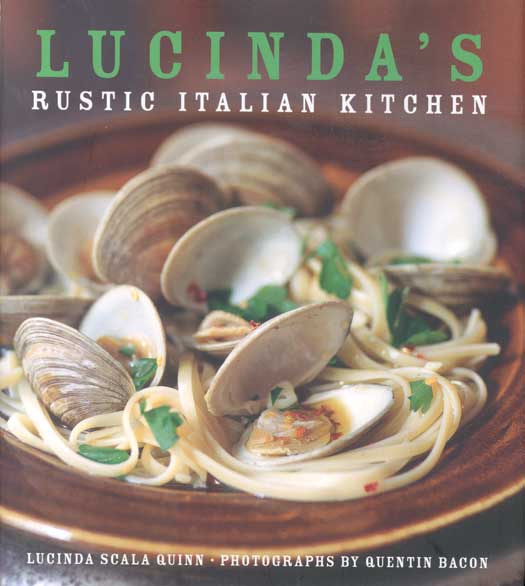
Lucinda’s Rustic Italian Kitchen
by Lucinda Scala Quinn
Published by John Wiley & Sons
Proscuitto With Fresh Fruit
This classic combination of salty prosciutto with sweet, cool melon is a refreshing way to start any meal. I like to use different kinds of fruit depending on what is the freshest available offering. Using a selection of different colored and textured melons is also very beautiful. For bite-sized hors d’oeuvres, cut the fruit into small pieces, wrap each piece with prosciutto, cut to size and serve with toothpicks.
-
1 medium-size ripe melon, peeled and cut into 8 wedges
8 figs or 8 halved peaches
2 limes or lemons, 1 cut in half, 1 cut in 8 wedges for garnish
Freshly ground black pepper (optional)
1 pound prosciutto, best quality, thinly sliced

Cut the fruit into the desired size. Squeeze the halved citrus over all the fruit. Crack freshly ground pepper over it, if desired. Place a piece on each plate and lay the prosciutto over each piece of fruit, cutting to size if necessary. Serve a wedge of citrus on the side.
Makes 8 servings.
Pizza Margherita
This basic Neapolitan-style pizza, Margherita, is perfect as is. Folks can also create their own personal pie on top of this basic formula, if you prepare bowls of your favorite thin-sliced vegetables, meats and cheeses to choose from.
-
1 package prepared pizza dough, divided into 6 pieces
1/3 cup yellow cornmeal
2 tablespoons extra-virgin olive oil
1 jar pizza sauce
1 pound fresh mozzarella, sliced thin
36 fresh basil leaves, washed and dried

Preheat the oven to 450 degrees. Put the oven rack in the upper part of the oven. Place a pizza stone or heavy bottomed baking sheet in the oven to preheat.
On a clean work surface, roll out the dough pieces to about 6 inches round and 1/4 inch thick. Pick up the dough and stretch further with your fingers. Prepare as many pies as will fit on the stone or baking sheet at one time. Spread some cornmeal on a large wooden pizza peel. Place the rolled dough on the wooden peel one at a time.
Lightly brush the entire pie with olive oil. Thinly spread 2 to 3 tablespoons of tomato sauce around the pie, leaving a 1/2-inch border of dough around the pie. Place 4 slices of cheese evenly around the pie. Lay on 4 to 6 basil leaves. Add other toppings, if desired, at this point.
Open the oven and pull out the oven rack. Working quickly, slide the pie with the flick of the wrist on to the hot stone or pan. Cook the pizza for 10 to 15 minutes, until the crust is golden and the cheese melted and bubbling. Serve immediately.
Makes six 6-inch individual pizzas.

My New Mediterranean Cookbook
by Jeannette Seaver
Published by Arcade Publishing
Eggplant Caviar
Each Mediterranean cuisine has its version of eggplant purée. In Turkey, Lebanon, and other parts of the Middle East, it is called baba ganoush; in France, caviar d ‘aubergine.
I prefer my version, a combination of the French and Romanian recipes (a Romanian friend in Paris gave me her recipe many years ago), which has no garlic — just onion —and is exquisitely smoky and smooth.
-
1 large eggplant
1 onion, chopped
Juice of 1 lemon
1 cup cilantro leaves
2/3 cup olive oil
1 tablespoon ground cumin
Pepper and salt
Lemon wedges
Pita bread, warmed
On an outside grill or directly over the flame of the gas stove, grill the eggplant on all sides. It will ooze some juice, shrink and look rather pitiful — don’t worry, that’s as it should be. Under running cold water, peel charred skin off. In the food processor, purée eggplant, onion, lemon juice, cilantro, olive oil, cumin, pepper and salt.
Transfer purée to serving platter. If you’re going to serve it that day, it isn’t necessary to refrigerate the eggplant caviar — just cover with plastic wrap. Serve with lemon wedges and warm pita bread.
Makes 4 servings.
Baby Bell Peppers Stuffed With Feta and Olives
This colorful recipe of small peppers, both crunchy and with a creamy stuffing, is Greek, but appears in slightly different forms in other countries of the Mediterranean basin.

-
8-10 baby red, yellow and green peppers
1/2 onion, minced
1 cup crumbled feta cheese
1/2 cup black olives, pitted and chopped
1/3 cup sour cream
1 teaspoon finely chopped fresh thyme
¼ cup olive oil
Wash peppers, and remove seeds and membrane, keeping peppers whole. Dry. Set aside. In the food processor, puree onion, feta cheese, olives, sour cream and thyme.
With a spoon, stuff each pepper with feta mixture. Place on serving platter. Drizzle with olive oil.
Makes 4 - 6 servings.

Savory Baking From the Mediterranean
by Anissa Helou
Published by William Morrow
Roquefort and Cherry Tomato Quiche
There are all kinds of different quiches in France and not all are made with the dense egg custard of a quiche Lorraine. This Roquefort quiche is light and sophisticated, with a delicate sauce made with fewer eggs than usual.
- 1 pre-made pie shell for 10-inch pie
2 tablespoons Dijon mustard
2 ounces Roquefort cheese, diced (about 1/2 cup)
1 pound cherry tomatoes
Scant 1 cup crème fraîche
2 medium eggs
Fine kosher salt or sea salt
Freshly ground black pepper
2 tablespoons finely chopped flat-leaf parsley
Preheat the oven to 400 degrees.
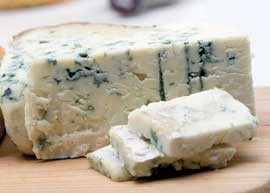 Line the pie shell with parchment paper and weigh it down with pie weights. Bake for 20 to 25 minutes, or until just colored. Remove from the oven and let cool for 15 to 20 minutes. Remove the pie weights and parchment paper.
Line the pie shell with parchment paper and weigh it down with pie weights. Bake for 20 to 25 minutes, or until just colored. Remove from the oven and let cool for 15 to 20 minutes. Remove the pie weights and parchment paper.
Spread the mustard all over the pastry. Scatter the Roquefort all over. Arrange the cherry tomatoes in an even layer. Beat the crème fraîche and eggs together, season with salt and pepper to taste, and pour over the cheese and tomatoes. Sprinkle with the chopped parsley.
Bake for 30 to 45 minutes, until the filling is set and both crust and filling are golden brown all over. Serve hot.
Makes 4 - 6 servings.
Moroccan Triangles With Minced Meat

-
For the filling:
1 tablespoon unsalted butter
1 small onion, very finely chopped (about 1/3 cup)
1 pound ground beef
Pinch of saffron threads
1/4 teaspoon crushed red pepper flakes
Fine kosher salt or sea salt
Freshly ground black pepper
2 medium eggs, beaten
1 tablespoon finely chopped cilantro
For the crust:
10 sheets phyllo pastry
1 stick unsalted butter, melted
Heat the 1 tablespoon butter in a large sauté pan over medium heat. Add the onion, beef, and saffron, and cook, stirring occasionally and pressing the meat with the back of a wooden spoon to break up lumps, until the meat is no longer pink. Add the red pepper flakes and season with salt and black pepper to taste. Set aside to let cool.
Preheat the oven to 400 degrees. Once the meat mixture has cooled to the point at which it will not cook the eggs, add the eggs and cilantro and mix well.
Cut the phyllo sheets in half lengthwise. Place 1 strip on a work surface and keep the others covered with plastic wrap or a slightly damp kitchen towel. Brush the strip with melted butter. Fold in half lengthwise and place about a tablespoon of the meat mixture near one end. Fold the end of the phyllo over the filling to form a triangle shape.
Brush the remainder of the strip with butter and continue folding, keeping to the triangle shape, until the strip is completely folded and the filling is enclosed. Cut off any excess pastry. Transfer loose side down to a nonstick baking sheet, or to a baking sheet lined with parchment paper or a silicone pastry mat. Brush the top of the triangle with butter. Make the remaining triangles in the same way.
Bake for 15 to 20 minutes, until golden brown. Serve hot or warm.
Makes 20 small triangles.
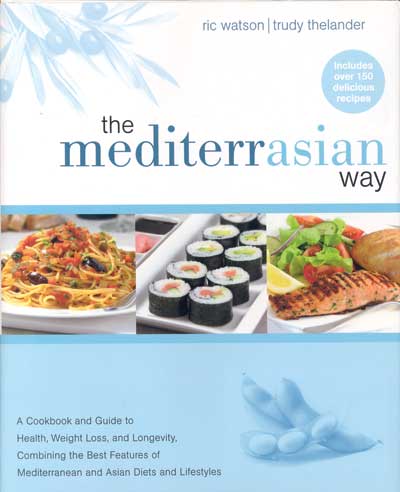 The Mediterrasian Way
The Mediterrasian Way
by Ric Watson and Trudy Thelander
Published by John Wiley & Sons
Focaccia With Smoked Salmon and Avocado
Focaccia stuffed with tender smoked salmon slices, creamy avocado and crisp salad vegetables.
-
7 ounces sliced smoked salmon
1 focaccia bread, cut in half lengthways
2 ripe tomatoes, sliced
1 avocado, sliced
12 thinly sliced rings of red onion
2 cups green mignonette or butter lettuce leaves
2 tablespoons freshly squeezed lemon juice
2 tablespoons extra-virgin olive oil
1/2 clove garlic, minced
1/2 teaspoon sea salt
1/2 teaspoon freshly ground black pepper
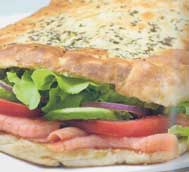 Arrange equal amounts of the smoked salmon on the base of the focaccia. Top with the tomato, avocado, red onions and lettuce. In a small bowl, mix together the lemon juice, oil, garlic, salt and pepper. Drizzle the dressing over the top, cover with the top half of the focaccia, and cut into quarters to serve.
Arrange equal amounts of the smoked salmon on the base of the focaccia. Top with the tomato, avocado, red onions and lettuce. In a small bowl, mix together the lemon juice, oil, garlic, salt and pepper. Drizzle the dressing over the top, cover with the top half of the focaccia, and cut into quarters to serve.
Makes 4 servings.
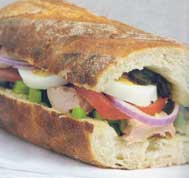 Pan Bagnat
Pan Bagnat
Literally meaning “bathed bread,” this sandwich, which originates from the Provence region of southern France, can be made up the night before to allow the flavors to mingle.
-
6 tablespoons extra-virgin olive oil
2 tablespoons white wine vinegar
1 teaspoon Dijon mustard
1 clove garlic, minced
1 teaspoon salt
1/2 teaspoon freshly ground black pepper
1 large baguette
12 ounces canned tuna in olive oil, drained and broken into pieces
1/2 green bell pepper, diced
2 ripe tomatoes, sliced
3 large eggs, hard-boiled, peeled and sliced
15 half rings of red onion
12 pitted black olives, sliced
Place the oil, vinegar, mustard, garlic, salt and pepper in a jar with screw-top lid and shake until well combined. Cut the baguette in half lengthways and remove some of the soft bread from the center of each half to hollow out a little.
Arrange the tuna, bell pepper, tomatoes, eggs, onions and olives on the bottom half, then drizzle with the dressing. Top with the other baguette half and wrap tightly with plastic wrap and refrigerate for at least 1 hour to allow the flavors to develop.
Bring to room temperature before cutting into quarters to serve.
Makes 4 servings.
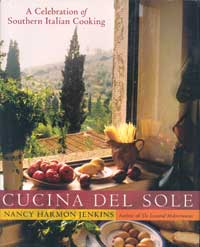 Cucina Del Sole
Cucina Del Sole
by Nancy Harmon Jenkins
Published by William Morrow
Potato, Sausage and Ricotta Omelet from Basilicata
- 1 medium potato (about 1 pound), peeled, halved and thinly sliced
2 tablespoons extra-virgin olive oil
2 ounces hot cured sausage, such as
capocollo, coarsely chopped
1 cup well-drained whole-milk ricotta, preferably made from sheep’s milk
6 eggs
Sea salt and freshly ground black pepper
Pinch of crumbled dried red chili (optional)
Combine the potato slices and olive oil in a skillet over medium heat. Cook, stirring frequently and breaking up the potato slices with the spatula rim, until the potatoes are very tender. Stir in the sausage and continue cooking.
In a bowl, combine the ricotta and eggs, adding salt, black pepper and, if you wish, chili to taste.
Turn the heat down low under the skillet and pour the egg mixture over the potatoes in the pan, lifting the potatoes to let the egg batter run underneath. Cook, continually shaking the pan and running a palette knife or a narrow spatula around the edges of the frittata to keep the eggs from sticking. From time to time, lift some of the cooked egg off the bottom of the pan to let uncooked egg run beneath.
When the frittata is thoroughly cooked on the bottom, set a platter upside down over the skillet and turn the skillet over so that the frittata drops onto the plate. Now slide the frittata back into the skillet and continue cooking for 30 seconds to 1 minute, or until the frittata is firm on the bottom. Turn the frittata out onto a serving platter and serve immediately.
If turning the frittata and sliding it back into the skillet seems tricky, try simply running the skillet under a preheated broiler to brown the top very lightly.
Makes 4 - 6 servings.
Fish in a Wine and Lemon Sauce
Have all your ingredients ready and measured ahead of time for this very quick and easy preparation. Good fish selections: Mackerel is traditional, but I have made this successfully with salmon fillets. It would also be good with bluefish in season or with drier fish like haddock or halibut. Adjust the cooking time to the thickness of the fish, but be careful not to overcook.
-
2 tablespoons extra-virgin olive oil
1-1/2 pounds mackerel or other fish fillets – at least 1 fillet per person
2 garlic cloves, minced
1 teaspoon crumbled dried red chili, to taste
Sea salt and freshly ground black pepper
Grated zest and juice of 1 lemon, preferably organic
3/4 cup dry white wine
1/4 cup mixed minced fresh basil and flat-leaf parsley
Set a skillet large enough to hold all the fish over medium heat and add the olive oil. While the oil is heating, pat the fish dry with paper towels.
Add the minced garlic to the oil and when it starts to sizzle, drop in the fish pieces. Sprinkle with red pepper flakes, salt and pepper to taste. After about 1½ minutes, carefully turn the fish, using 2 spatulas if it’s helpful, to brown the other sides. Sprinkle the grated zest over the top and add the lemon juice to the pan.
Let cook for 1½ minutes, then add ½ cup of the wine to the pan along with half the minced herbs. Lower the heat to simmer, cover the pan, and cook for 4 to 5 minutes, or until the fish flakes easily with a fork.
Transfer the fish pieces to a warm platter and raise the heat under the pan. Add the remaining ¼ cup wine and cook rapidly, scraping up the brown bits. At the last minute, swirl in the remaining herbs, remove from the heat, and pour the juices over the fish on the platter. Serve immediately.
Makes 4 - 6 servings.
 Cooking With Les Dames D’escoffier
Cooking With Les Dames D’escoffier
Edited by Marcella Rosene with
Pat Mozersky
Published by Sasquatch Books
Breakfast-for-Dinner Salad
There were many years of cooking school and apprenticing in star-studded kitchens before Los Angeles Dame Mary Sue Milliken teamed up with Dame Susan Feniger in 1981 to open their first of several restaurants. Even now, after all their success in food —including a few hundred episodes of “Too Hot Tamales” for the Food Network — Milliken says, “When it comes to cooking I still feel like a teenager. I cook every day and I enjoy every minute in the kitchen.”
Milliken recommends this one-dish dinner for two: fresh greens and poached eggs, which she serves frequently in her household for “breakfast, lunch, or dinner.“
The vinaigrette can be prepared ahead of time and stored in the refrigerator. Before using, allow it to sit at room temperature for 20 to 30 minutes. Greens can be washed, dried and measured ahead. The croutons, likewise (quickly reheat before sautéing the bacon). Even the eggs can be cooked ahead and reheated.
-
½- to 1-inch pieces of crusty bread fried in oil with salt and pepper to make croutons
4 to 6 thick slices bacon, cut into 1-inch pieces
2 thin slices red onion
1/4 cup extra-virgin olive oil
1 tablespoon cider vinegar
1 teaspoon Dijon mustard
2 cloves garlic, minced or put through a garlic press
1 teaspoon freshly squeezed lemon juice
1/2 teaspoon salt
5 grinds black pepper
2 eggs
6 cups assorted salad greens like romaine, escarole, watercress, and arugula
2 tomatoes, seeded and diced
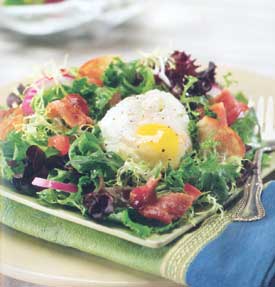
Make the croutons. Using the same skillet as for the croutons, fry the bacon over medium heat until golden and crispy. Remove with a slotted spoon and drain well on paper towels. (Or, preheat the oven to 400 degrees and place the bacon on a foil-lined baking sheet, and bake just until crisp, about 15 minutes. Remove the bacon from the oven, transfer to paper towels and reserve.)
Meanwhile, soak the onion slices in ice water for 2 to 3 minutes and drain on a paper towel. Separate into rings. Reserve.
In a small jar, combine the olive oil, vinegar, mustard, garlic, lemon juice, salt and pepper. Shake vigorously to combine.
Poach the eggs but don’t cool them in ice water. Rather, simply drain them on paper towels.
Toss the salad greens in a large bowl with the onion, tomatoes, bacon and croutons. Sprinkle about 3 tablespoons of the dressing on the mixture and toss to coat all ingredients evenly. Add the remaining dressing to taste.
Divide the salad onto 2 plates and top each with a warm poached egg. Serve immediately.
Makes 2 servings.
Creamy Feta Potatoes
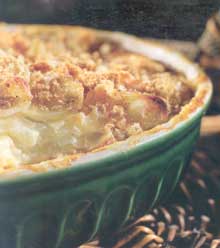
Celebrity chef and Washington, D.C., Dame Ris Lacoste served these creamy feta potatoes with a rack of lamb and a red-pepper purée throughout the decade she was executive chef at the celebrated D.C. restaurant 1789.
Lacoste, after graduating from the University of California at Berkeley with a degree in French, went off to Paris to practice the language. She happened to take a part-time typing job at the Ecole de Cuisine La Varenne. The school’s founder and president, Grande Dame Anne Willan, spotted the young Lacoste’s flair for food and proposed that she be her personal assistant by day and a full-time cooking student at night.
Two years later, Lacoste finished her La Varenne training, and she’s been working as a chef ever since.
-
2 tablespoons unsalted butter
4 cups finely diced onion
2 cloves garlic, minced
8 ounces imported Greek feta cheese, crumbled
Butter to grease pan
1-1/4 cups heavy cream
1 cup whole milk
1/2 teaspoon salt
2 pounds (about 3 large) russet potatoes, peeled and covered with water
Freshly ground black pepper
1/2 cup breadcrumbs
Melt the butter in a large skillet. Add the onions and cook until soft but not browned, about 5 minutes. Add the minced garlic and cook 1 minute longer. Remove the skillet from the heat and cool. Stir in the feta cheese. Reserve.
Preheat the oven to 350 degrees. Butter a 9- by 13-inch baking dish. Put the cream, milk and salt in a saucepan and heat to just under a boil. Remove from the heat and reserve.
To avoid discoloration, slice the potatoes one at a time, as you need them, to create each layer. Slice 1 of the potatoes — either on a mandoline, or with a 2-mm slicing blade on the food processor, or by hand — into 1/8-inch slices and line the bottom of the dish. Season the layer with about 8 grinds of black pepper (do not salt the layers).
Cover with one third (about 1 cup) of the onion-feta mixture. Repeat two more layers, leaving enough sliced potatoes for a top layer. Pour the hot cream mixture over the top layer. The cream should reach to the top of the potatoes but not cover them. Add another 8 grinds of black pepper. Do not cover the dish for baking.
Bake for 20 minutes. Remove the pan from the oven and use a large spoon or a bulb baster to baste the top potatoes with the cream from the corners. Return the pan to the oven and bake for 40 minutes. Sprinkle the top with the breadcrumbs.
Continue to bake until the crumbs brown, 15 to 20 minutes longer. The potatoes should be fork tender and the cream nearly absorbed. Let sit for up to 20 minutes before serving (if necessary, briefly reheat).
Makes 6 - 8 servings.
 Fine Cooking Annual, Vol. 3
Fine Cooking Annual, Vol. 3
by Fine Cooking Magazine
Published by the Taunton Press
Chicken Breasts Stuffed With Prosciutto, Parmesan & Sun-Dried Tomatoes
This chicken, with its crisp skin, tender meat and savory filling, will surely become a favorite.
-
3 tablespoons freshly grated Parmigiano-Reggiano
2 tablespoons finely chopped prosciutto
2 tablespoons finely chopped, well-drained sun-dried tomatoes
1 teaspoon finely chopped fresh sage or 1/4 teaspoon dried sage
1 tablespoon plus 1 teaspoon unsalted butter, softened
Kosher salt and freshly ground black pepper
2 boneless, skin-on chicken breast halves
1 tablespoon olive oil

Heat the oven to 450 degrees.
In a small bowl, combine the Parmigiano, prosciutto, sun-dried tomatoes, sage and 1 tablespoon of the butter; mix until well blended. Taste and season with pepper and possibly more salt; the mixture should be highly seasoned.
Gently slide your index finger under the skin of one chicken breast to create a small pocket. Scoop up some of the filling and push it into the pocket, spreading it as evenly as possible. Do this in a few places until you’ve used half the filling and covered the top of the breast, but be careful not to completely detach the skin from the meat. Stretch the skin over the filling and breast as evenly as possible.
Repeat with the second breast. Chill in the freezer for about 5 minutes to let the filling firm up.
Heat a cast-iron or other heavy-based ovenproof skillet on the stove over medium-high heat. Season both sides of the chicken with salt and pepper. When the pan is hot, add the oil and the remaining 1 teaspoon butter. When the butter stops foaming, add the chicken breasts, skin side down. Don’t try to move them for at least 1 minute or the skin might tear. After 1 minute or so, you can move them around to be sure they’re not sticking. Cook until the skin side is well browned, about 4 minutes.
Carefully slide a thin spatula under the chicken and flip it over, taking care not to rip the skin. Put the pan in the hot oven and continue cooking until the chicken is no longer pink inside, about 10 minutes, or until an instant-read thermometer registers 165 degrees at the thickest part.
Take the breasts from the oven, let them rest for 3 to 5 minutes tented with foil, and then serve immediately.
Makes 2 servings.
Grilled Rosemary Chicken Skewers With Sweet & Sour Orange Dipping Sauce
Chicken thighs lend themselves to kebabs, which make a nice change of pace on the grill.
-
1 tablespoon plus 1 teaspoon minced fresh rosemary
2 teaspoons dark brown sugar
2 teaspoons kosher salt
1 teaspoon freshly ground black pepper
1 teaspoon crushed red pepper flakes
2 tablespoons vegetable oil; more for the grill
2-1/2 pounds boneless, skinless chicken thighs (about 8 large, 10 medium or
12 small), trimmed of excess fat, sliced into 1-1/2-inch-wide strips
1 cup orange marmalade
1/4 cup rice vinegar

In a small bowl, mix the 1 tablespoon rosemary with the brown sugar, salt, pepper and red pepper flakes. In a shallow pan, drizzle the oil over the chicken and toss to coat. Sprinkle the chicken evenly with the rosemary mixture.
Warm the marmalade, vinegar and remaining 1 teaspoon rosemary in a small saucepan over low heat until just warm; set aside in a warm spot.
Prepare a hot charcoal fire or heat a gas grill with all burners on medium high for 10 minutes. Thread the chicken onto skewers (soak wood skewers in water for at least 20 minutes first), folding each strip in half as you skewer it. If some strips are very thick, cut them in half crosswise rather than folding them so that all the pieces of chicken are roughly the same size. Clean the hot grate with a wire brush and then lubricate it with an oil-soaked paper towel.
Grill the skewers, turning them every 4 to 5 minutes as dark grill marks form, until cooked through, 12 to 15 minutes total.
Serve hot, warm, or at room temperature with individual bowls of warm marmalade dipping sauce.
Makes 4 - 6 servings.


